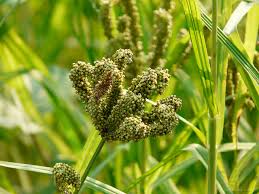
Disease management in Finger millets
Share
Introduction
Finger millet (Eleusine coracana), also known as ragi, is a crucial cereal crop cultivated primarily in Africa and Asia. It is valued for its high nutritional content, resilience to harsh climatic conditions, and ability to grow on poor soils. However, like any other crop, finger millet is susceptible to various diseases that can significantly impact yield and quality. Effective disease management is essential to ensure healthy crop production and sustainable agriculture. This article provides an overview of common diseases affecting finger millets and strategies for their management.

Blast: Pyricularia grisea
Symptom:
Infects at any stage of the growth from the seedling to the grain formation stage
The infection appears in the nursery from the second week of germination and spreads quickly to the entire nursery as well as to the main field.
Small brown circular to elongated spots appear on leaves which eventually develop into large, elongated spindle shaped areas in the seedling stage. Young leaves dry completely in the nursery itself
The spindle shaped spots appear on leaves in the main field. Several spots coalesce and cause drying of foliage
Maximum damage is caused by the neck blast. The neck region turns black and shrinks.
Infection occurs at the basal portions of the panicle branches including the fingers and the ear head breaks away from the stalk. The affected portions turn brown, and ears become chaffy and only few shriveled grains are formed
Some of the fingers are also affected causing finger blast. The fingers become chaffy and only few shriveled grains are formed.

MANAGEMENT:
Cultural method:
Use disease free seeds
Grow resistant varieties like CO RA (14), Paiyur (RA)-2, GPU-28, GPU-45, GPU-48, L-5 Proper plant spacing and transplanting is advisable
Early sowing (July month) reduces the blast severity
Biological method
Spray Pseudomonas fluorescens (Pf1) at 2 g/lit of water. First spray immediately after noticing the symptom. Second and Third sprays at flowering stage at 15 days interval
Treat the seed with Pseudomonas fluorescens @ 6g/Kg seed and spray the extracts of Prosopis juliflora leaf extract (10%), Ipomoea carnea leaf extract (10%)
Foliar spray with premixture fungicide (Carbendazim+Mancozeb) @ 0.2% concentration at 50% earhead emergence followed by a second spray with Pseudomonas fluorescens (Pf1) at 2g/lit of water 10 days later

Chemical method
Seed treatment with carbendazim @ 1 gm/Kg of seed
Spray Carbendazim 0.1% in nursery 10-12 days after sowing. Repeat the spray 20-25 days after transplanting and 40 to 45 days after transplanting
Spray any one of the fungicides Carbendazim 500 g or Iprobenphos (IBP) @ 500 ml/ha or premixture fungicide (Carbendazim+Mancozeb) @ 500g/ha. First spray immediately after noticing the symptoms. Second and third sprays at flowering stage at 15 days interval to control neck and finger infection.
Summary:
Finger millet, a hardy grain, can be susceptible to Blast disease caused by the fungus Pyricularia grisea. This disease strikes at any growth stage, from seedlings to grain formation. Early signs include brown spots on leaves that enlarge and dry out young plants. In the field, Blast blackens the neck of the finger millet, causing the head to detach. Additionally, individual fingers can become infected, resulting in stunted growth and reduced grain yield.
Fortunately, multiple methods can be employed to combat Blast. Planting disease-resistant varieties and ensuring proper spacing and early sowing are crucial preventative measures. Furthermore, beneficial bacteria like Pseudomonas fluorescens and natural plant extracts offer biological control options. Chemical fungicides can also be used as a last resort, with seed treatment and targeted sprays throughout the growing season proving most effective. By implementing a combination of these strategies, finger millet farmers can safeguard their crops and achieve optimal yields.
